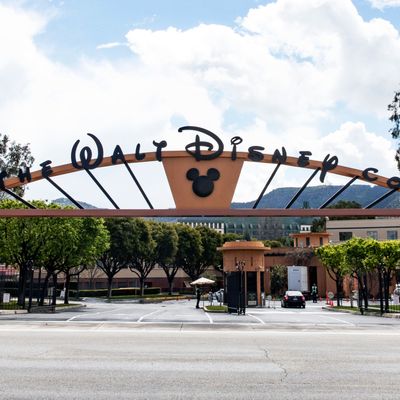
On Monday, the news exploded out of Burbank with the subtle force of a Mickey Mouse–shaped bunker bomb. Buoyed by the expectations-defying early success of Disney+, the Walt Disney Co. announced plans to reorganize its entertainment operations with streaming as the new primary focus — accelerating a “direct-to-consumer” strategy that was already under way, in implicit recognition of theatrical moviegoing’s diminishing commerciality in the COVID-19 era.
The immediate takeaway: Disney, Hollywood’s most dominant box-office force, the hoariest of legacy-media monoliths, and most image-manicured studio in the 30-mile zone, was shifting emphasis away from the blockbuster biz and committing its not inconsiderable resources toward trying to eat Netflix’s lunch.
In interviews this week, Disney chief executive Bob Chapek didn’t exactly discourage that perception, framing the pivot as capitulation to market realities — giving the people what they want, where they want it. “The consumers are actually going to be who makes these decisions,” he said on CNBC. “Right now, they’re voting with their pocketbooks and they’re voting very heavily towards Disney+.”
In the aftermath of the Summer of No Blockbusters, the studio’s streaming-first strategy was understood as another harbinger of the impending big-screen apocalypse. It arrives just days after the global theater chain Cineworld’s temporary closure of 536 locations worldwide due to a “challenging theatrical landscape,” and the Mouse House deciding to skip a multiplex release for Pixar’s presumed blockbuster Soul to debut the animated family film on Disney+ in December (a move that has “shocked and dismayed all cinema operators” according to a statement by The International Union of Cinemas).
Upon closer inspection, however, Disney’s reorganization may not end up being as revolutionary as theatrical doomsayers initially believed. While the prioritization of streaming is certainly a declaration of purpose intended to bolster shareholder confidence — one that has already delivered richly with Disney stock rising 4.7 percent on Tuesday, to add around $11 billion in market capitalization — it is unlikely to much alter studio operations until deep into 2021 at the earliest. Moreover, given the unique and incredibly specific parameters of Disney’s magic media kingdom, other studios probably won’t follow suit.
So then is the announcement an empty exercise in Hollywood corporate doublespeak? Or is some agenda yet to be revealed?
What Exactly Does Disney’s “Reorganization” Entail?
Under the new corporate configuration, the studio’s intellectual properties will be effectively bifurcated. One arm of the company will exclusively produce content (movies, TV shows, sports programming), while a separate, newly dedicated phalanx of executives oversees nothing but distribution concerns (slotting said content either into theaters or, increasingly, onto Disney-owned streamers and networks including Disney+, Hulu, ESPN+, NatGeo and FX).
Of course, things were not always this way. Up until the shakeup, the creation and distribution of new movies was far less centralized and decidedly less bureaucratic. Motion pictures wended their way through production with in-house distribution executives keeping an eye on every twist in the supply chain. But Disney has tilted the paradigm by wresting the levers of theatrical and streaming control away from individual studio divisions such as Pixar, Marvel and Lucasfilm and placing it in the hands of Big Disney.
“Managing content creation distinct from distribution will allow us to be more effective and nimble in making the content consumers want most, delivered in the way they prefer to consume it,” Chapek said in a statement this week. “Our creative teams will concentrate on what they do best — making world-class, franchise-based content.”
What Does It Mean for the Studio?
Theoretically speaking: that Steven Spielberg can fine tune West Side Story without a thought to how it will be positioned in the movie marketplace. Marvel’s Kevin Feige can maintain focus on bringing Shang-Chi and the Legend of the Ten Rings to its own feature-film standards in a platform-agnostic way. And Lucasfilm’s Kathleen Kennedy can ready the second season of The Mandalorian for a presumed Disney+ audience even if that is not where the show ultimately ends up.
In a break from standard operating procedure, Disney’s New Media and Entertainment Distribution Group (led by former consumer products chief Kareem Daniel) will decide if those properties wind up in theaters or or on streaming — or both, or even some as-yet unrealized combination of multiple OTT services and cable — determining the particulars of how studio output is monetized in new and potentially groundbreaking ways.
So will it work? According to longtime Disney analyst Rich Greenfield of Lightshed Partners, the restructuring is unlikely to affect studio operations anytime soon. With Mulan, Artemis Fowl and the filmed adaptation of Hamilton already having skipped theaters to debut on Disney+ earlier this year, and all the studio’s upcoming tentpole titles — Black Widow, Raya and the Last Dragon, Marvel’s The Eternals and The King’s Man among them — arriving in theaters in mid- to late-2021, Greenfield notes that Disney distribution execs will be under no pressure to scrap theatrical releases for streaming for more than a year.
“While the market is very excited by yesterday’s restructuring news (as anything that fuels investor hope that Disney does actually want to transform into Netflix is celebrated), the reality is far less clear,” he wrote in a note co-authored by Brandon Ross and Mark Kelley that was published October 13. “In fact, it is not clear that anything significant is going to change in the short term.”
What Does This Mean for the Movie Industry?
Even badly weakened by continuing Disneyland and Walt Disney World closures that resulted in layoffs for 28,000 theme park employees last month and the company’s parks division reporting a $2 billion third-quarter loss, Disney remains the industry’s reigning box-office colossus and, as such, a kind of Hollywood thought leader. Question is whether other studios will follow its charge into the Streaming Wars, shifting the town’s business mindset in the process. After all, Comcast and WarnerMedia have already taken similar steps to scramble teams of executives and shift resources toward direct-to-consumer ventures, HBO Max and Peacock, that offer a financial bulwark at a time when domestic ticket sales remain on life support.
To date, none of Disney’s studio competition have attempted the all-in bet to pursue subscribers rather than first-weekend box-office gross. That could be because unlike its competitors, Disney has structured the sum total of its brand identity around family-friendly franchises. Unlike the competition, Disney has a stable of studio divisions that are reliable blockbuster factories in their own rights. And no other studio can match Disney’s overwhelming IP fire power, which generates Hollywood’s greatest diversity of downstream revenues from licensing, merch and other ancillary businesses.
But given the enormous production and marketing outlays for most popcorn movie titles — event films like, say, F9, a franchise epic with a nine-figure budget and demonstrated blockbuster appeal — the pivot to streaming is still not considered cost effective at a time when adhering to theatrical “release windows” remains the dominant strategy. In Greenfield and company’s view, not even for Disney. “While we remain confident that streaming economics in totality are far superior long-term than traditional movie/tv economics,” the analyst opines, “nothing can achieve the per picture economics that Disney is able to generate through a global theatrical release; [making] it very hard economically for Disney to pivot away from windowing.”



